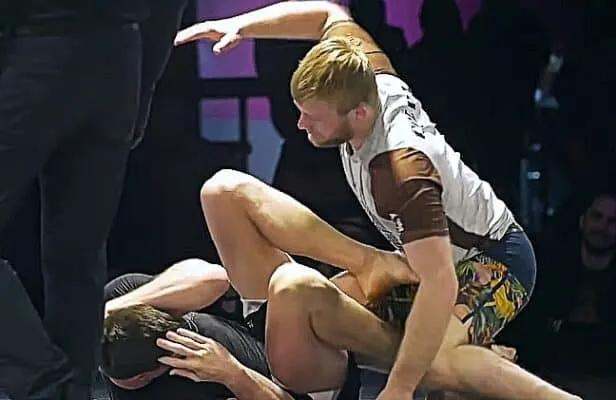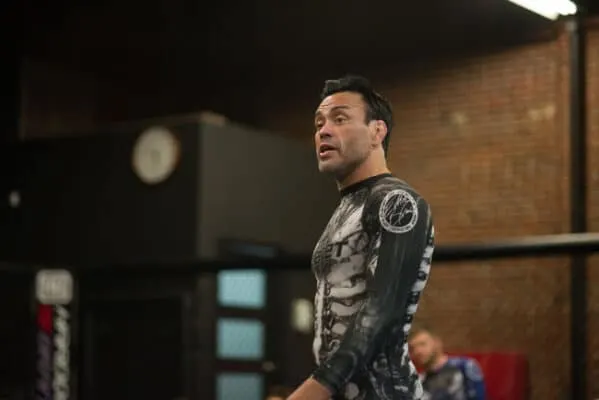
Brazilian Jiu-jitsu(BJJ) is one of the most popular and fastest-growing martial arts in the world. This popularity is largely due to the success of MMA, where Jiujitsu has been tested against various other martial arts and proved its effectiveness time and time again. Since its inception, there have been various modified versions of Jiu-jitsu. One that intrigues many people is Combat Jiu-jitsu or CJJ.
Combat Jiu-Jitsu(CJJ) is a hybrid version of Brazilian Jiu-Jitsu that was primarily developed by Eddie Bravo to make Jiu-Jitsu matches closer to reality-based like Mixed Martial Arts(MMA). CJJ incorporates Jiu-Jitsu techniques with open palm strikes to make Jiu-Jitsu matches much more realistic.
Read the below to find more interesting facts about this unique style of Jiujitsu and why you should consider this unique style of Jiujitsu
What is Combat Jiujitsu?
Combat Jiu-jitsu is a hybrid version of Brazilian Jiu-jitsu that combines hand slapping (open palm strikings) with the sport of Jiu-Jitsu. The key goal of designing Combat Jiu-Jitsu was to make Jiu-jitsu more practical in real-life altercations by allowing competitors to strike each other on the ground with open hand slaps. Combat Jiu-Jitsu matches can only be won by submission or TKO.
RECOMMENDED FOR YOU: What is Japanese Jujutsu? Here’s What You Should Know
Who Invented Combat Jiu-Jitsu?
The 10th Planet Jiu-Jitsu founder and visionary coach, Eddie Bravo, primarily developed Combat Jiu-Jitsu because he felt that rules-orientated competition in Brazilian Jiu-jitsu had become overly saturated with stall tactics and unrealistic moves, which deviated from being a true martial art for self-defense. For this reason, Eddie developed Combat Jiu-jitsu to become more applicable in self-defense situations.

HIGHLY RECOMMENDED: What Makes John Danaher the Greatest BJJ Coach? A Closer Look
Brief History of Combat Jiujitsu
When Eddie Bravo first showcased the concept of combat Jiu-Jitsu in 2013 and initially was scoffed at by some of the high-level BJJ practitioners. But the eccentric rubber-guard pioneer held the belief that competition rulesets such as IBJJF had moved away from the intended purpose of the martial art and was at risk of becoming less practical as a form of self-defense. By introducing open-palm strikes to the ground-based grappling, Bravo hoped to replicate real-life altercations with a higher degree of authenticity.
These open-palm strikes cause CJJ to appear to be similar to Japanese hybrid wrestling promotions such as Pancrase, which were popular in the early 2000s but in many ways brings CJJ closer to the Kodokan Judo Mitsuyo Maeda taught Carlos Gracie in the early 20th century. In fact, video recordings of Gracie challenge from the ‘80s and ‘90s tend to show the defending Gracies using slaps and punches in order to advance their position.
After creating CJJ, Bravo began running competitive matches at his invitational events. At Eddie Bravo Invitational(EBI) 11th event, Chad George, JM Holland, Sheridan Moran and Nick Honstein competed for the bantamweight title. For the attending crowd, these 135 lbs provided the most exciting bouts of the evening, with the big slaps drawing cheers from the audience. At the same time both high-level MMA and BJJ athletes giving the matches credence on social media platforms, even if some did compare the events to being like Russian slapping contests.
The invitationals have done their bit to increase curiosity in Combat Jiu-Jitsu and consequently, more Jiu-Jitsu athletes have come to give the slap and grapple game a go. Since then, Bravo has begun hosting Combat Jiu-Jitsu Worlds events, with the first one happening in 2018.
RELATED: What is Gracie Jiu-Jitsu? Fully Explained
What Are Combat Jiu-Jitsu Rules?
- CJJ rules are significantly less complex than regular BJJ rules. This is largely due to there being no point system.
- CJJ matches are only won by submission, TKOs caused by the open-hand slaps, or by EBI overtime rules.
- All submission moves are allowed.
- Matches are only one round and last ten minutes. At the end of the ten minutes, if there are no submissions or TKOs, matches continue in overtime round.
- Only one minute is allowed for stand-up grappling. The referee will then stop the action and employ the “get down rule”, where a coin flip will occur. The winner of the coin flip chooses whether they want to begin with double underhooks on the bottom, or on top in butterfly guard.
- Open palm striking is ONLY allowed on the ground.
- Purgatory Position is when one competitor is on the ground while their opponent is standing and stalling action. A competitor can only be in purgatory position for thirty seconds. Any time past this 30 seconds is added to the overtime round.
- When one competitor stands up while entangled with their opponent, this is not purgatory position.
Combat Jiu-Jitsu EBI overtime Rules
The following information about EBI Overtime rules is sourced from Eddie Bravo’s 10th Plannet JJ site.
- If neither competitor has won by TKO or submission after ten minutes of competition, overtime rules start with a coin toss. The winner of this toss is given the option of attacking from the back, “spiderweb” or from an armbar position.
- The competitor who goes first is referred to as competitor A, the other is competitor B.
- If competitor A secures a submission, competitor B is given the same amount of time and has to secure a submission faster than competitor A to win the match. If competitor B is unable to secure a submission faster than competitor A, competitor B loses.
- If competitor A can’t secure a submission and competitor B escapes, then the round continues with competitor B on offense. If B secures a submission, then B is the winner. If B does not secure submission and A escapes, then it goes to the second round of overtime.
- If after 3 rounds without a winner due to escapes, all the escapes times are added up. The competitor with the quickest overall escape time is the winner.
RELATED: What is ADCC Submission Fighting World Championship? A Simple Guide
Can You Strike in Combat Jiu-jitsu?
Standing strikes or kicks aren’t allowed in Combat Jiu-Jitsu, perhaps as this would make the sport too similar to MMA, but open-hand slaps are allowed when at least one competitor is on the ground. As of 2017, a fighter with their back on the ground can also swing up-kicks if their opponent is still standing. Punches, knees and elbows are not allowed and there is an emphasis on the slaps being used to open up guards, prevent stalling and progress fighters’ attempts to score submission victories.
What Is the Key Difference Between Combat Jiujitsu and BJJ?
The key difference between Combat Jiujitsu and BJJ is of course the addition of ground-based open palm strikes and up-kicks. CJJ is also more akin to no-gi competitions with submission rules.
Traditional sport Brazilian Jiu-Jitsu matches can be won via both submission and on points, while Combat Jiu-Jitsu has no point system. BJJ has become significantly more sports orientated since the mid ‘90s and for some, both no-gi and gi-based variants of BJJ have become stagnant, with guard pulling techniques slowing down the pace of matches. CJJ is much more face paced to simulate the real fighting.
RECOMMENDED FOR YOU: BJJ vs Japanese Jiu-Jitsu – Key Differences and Similarities
Combat Jiujitsu vs BJJ – Which One Should I Choose?
Choosing whether to train CJJ or BJJ generally comes down to two key factors. The first one is your reason for training – if you want more practicality, then BJJ is arguably much more useful. By allowing slaps, CJJ becomes somewhat closer to replicating a street fight. BJJ is traditionally seen as “the gentle art” and while injuries do happen as they do in any contact sport, the vast majority of practitioners can have a hard sparring session and still turn up to work today looking presentable. CJJ can put the martial artist at risk of perforated eardrums, or facial bruising which not everyone is prepared to do.
While CJJ is becoming more popular, finding classes in your local area may not be the easiest feat. Additionally, most of the classes you are likely to find are run by BJJ gyms with traditional gi or no gi classes. Attending a CJJ may be a privilege afforded to only trusted members of the gym’s class i.e. those who have been training BJJ for either months or years under the watchful eye of the head instructor.
If you are entirely new to either variant, then training both Gi and No-Gi BJJ would allow you to focus on the fundamentals of the art before mixing in somewhat jarring slaps. Training in a vacuum allows you to perfect the techniques before testing them in increasingly realistic scenarios.
It is also worth stating that some people like training martial arts for different reasons. The practicality of arts like Aikido and various forms of Kung Fu are often disputed, but some find training these arts to be therapeutic, fun, or reconnecting to an older culture in a similar manner to historical re-enactment societies. Unless your opponent just happens to be wearing a suit or a jacket, gi-techniques have fairly limited usage in a bar fight or if you’re defending against a mugger, but that is not to say that gi-jiu jitsu can’t be fun, or provide a great learning experience.
